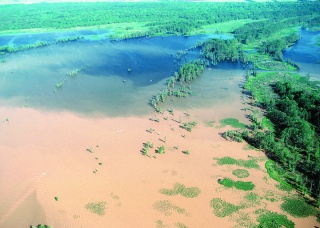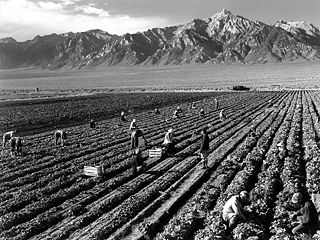Sediment
Sediment Overload

Sedimentation caused by human or natural activities can have drastic effects on corals and will probably lead to catastrophic results on them. The Status of Coral Reefs of the World (2004) report states that sediment run-off is the major stressor to reefs in Hawaii, Guam, and the Northern Mariana Islands, while the Coral Reefs of the USA (2008) and The State of Coral Reef Ecosystem of the United States and Pacific Freely Associated States (2008) reports point out that sediment run-off is also one of the most serious stressors affecting coral reefs in American Samoa, Puerto Rico, and US Virgin Islands [1]. Sedimentation and some other types of pollution including excessive nutrients, toxins and pathogens are all examples of the land-based sources of pollution, which put 22 percent of coral reefs on Earth at risk [2]. As a result, it is important to understand how sediment overload can damage the corals.
Definition of Sediments
Broadly speaking, sediment is a naturally occurring material that is broken down by processes of weathering and erosion, and is subsequently transported by the action of wind, water, or ice, and/or by the force of gravity acting on the particle itself.
In this article, the sediments we talk about are in shores and shallow seas and consist of mainly the terrigenous materials that originate on land and biological materials originating in the body of water.
Sources of Sediments

Sedimentation can be caused by human activity or natural processes.
- The largest source of sediment as a result of human activity is agriculture. Due to poor agricultural practices, top soil is carried away by rainfall and then enters the nearby bodies of water. Many traditional methods of irrigation, including flooding irrigation, make great contribution to the runoff of sediments, as the excessive amount of water can easily wash away the surface soil. The removal of native vegetation for the cultivation and harvesting of crops will leave the soil unsupported thus causing erosion, a process which helps sedimentation. Fertilizers, pesticides, herbicides and other agricultural materials will also be carried away by water as sediments. The livestock manure along with significant amount of nutrients are also an important components of the sediments. A large part of the sediment in various bodies of water will finally enter the worlds oceans.
- Deforestation accelerates the process of sedimentation. Litter, stems and trunks of trees can slow down surface runoff. However, if the trees are removed, the soil becomes drier and less coherent, thus easier to be washed away. As a result, the runoff of sediments and soil erosion will increase dramatically and large amounts of soil will enter nearby bodies of water. Also, deforestation increases the possibility of landslide, which is capable of moving soil into nearby rivers or lakes and finally to the ocean.
- Construction near rivers, lakes or shores will create enormous amounts of sediment. Coastal development is a major contributor to the sedimentation. It is estimated that 30 percent of worlds coral reefs are in risk because of coastal developments[2]. As the population grows fast in many developing island countries, the demands for housing, roads, ports and other developments are also expanding quickly. Poorly managed coastal development creates large amount of sediment runoff that go directly into ocean.
- Untreated sewage or industrial discharge may also contribute to the increasing amount of sediment.
- Beside the land-originated sediment, there are also marine-originated sediments. Dredging is a process to obtain sand and corals for building materials or beach replenishment and to deepen navigation channels and harbors [3]. It can result in large amounts of sediment in bodies of water.
- Bio-erosion in the ocean and the decomposition of dead marine organisms are sources of marine-originated biological sediments.
- Natural disasters like earthquakes and tsunamis can also lead to the increase of sediments.
Effects of Sediments
Increased sediment delivery to coastal waters is a key stressor on coastal ecosystems.
- The major effect is that the sediments floating in the water can screen out the sunlight needed for growth of coral [4]. Corals rely on the symbiotic relationship with a kind of single-celled algae called zooxanthellae, which is responsible for providing corals with nutrients formed by photosynthesis. Increasing turbidity from sedimentation will reduce the light available for photosynthesis of the zooxanthellae, thus reducing the amount of nutrients that the corals obtain. As a result, the growth rate of the corals will be limited. If the water remains highly turbid for a long time, coral bleaching will occur as the zooxanthellae leave the coral and will probably cause the death of coral[4]. Herbicides and other chemicals in the sediment are also very harmful for the zooxanthellae and will lead to coral bleaching as well.
- Sediment overload has many direct influences on corals.
- Firstly, large amounts of sediment that cover the surface of corals may cause the death of corals due to smothering.
- Secondly, corals have to spend more energy on cleaning by ciliary action instead of on growth, predation and other important activities [5].
- Thirdly, the sediments may inflict direct physical damages to corals by abrasion.
- The high turbidity as a result of sedimentation also has great impacts on the recruitment of coral. According to some research, corals will have low recruitment in high-turbidity environment[3]. Thus, the survival of juvenile coral is threatened since they are unable to find suitable substrate that is not covered with sediment.
- Turbid water also threatens coral fishes since most fishes are sensitive to water quality. If the water has too much sediment, fishes which feed on zooplankton or alga will move to deeper water. Then the population of zooplankton and alga will expand quickly and cause the oxygen depletion, threatening both zooxanthellae and corals.
- Sediments consist of various nutrients from agricultural runoff or domestic sewage. Eutrophication will occur as the nutrients enter the ocean, resulting in algal blooms. The presence of algae on substrate can inhibit colonization by larval recruits, thereby initiating a decrease in live coral cover and an increase in algal or other vegetative cover, as well as oxygen depletion[4].
- Many toxic chemicals such as pesticides are also carried away by water and flow into rivers and finally arrive in ocean water. Those toxins are also harmful for corals and the symbiotic algae.
References
- ↑ "Circulation and Sediment, Nutrient, Contaminant, and Larval Dynamics on Reefs."USGS Pacific Coral Reef Studies, Sediment Studies. N.p., n.d. Web. 16 Apr. 2014.. Retrieved from http://coralreefs.wr.usgs.gov/sediment.html
- ↑ 2.0 2.1 "Pollution." NOAA's Coral Reef Conservation Program:. N.p., n.d. Web. 16 Apr. 2014. Retrieved from http://coralreef.noaa.gov/threats/pollution/
- ↑ 3.0 3.1 Rogers, Cs. "Responses of Coral Reefs and Reef Organisms to Sedimentation."Marine Ecology Progress Series 62 (1990): 185-202. Print.
- ↑ 4.0 4.1 4.2 Burke, Lauretta Marie., and Jonathan Maidens. Reefs at Risk in the Caribbean. Washington, D.C.: World Resources Institute, 2004. Print.
- ↑ The Effects of Terrestrial Runoff of Sediments, Nutrients and Other Pollutants on Coral Reefs. ISRS Briefing Paper 3. International Society for Reef Studies. Print.